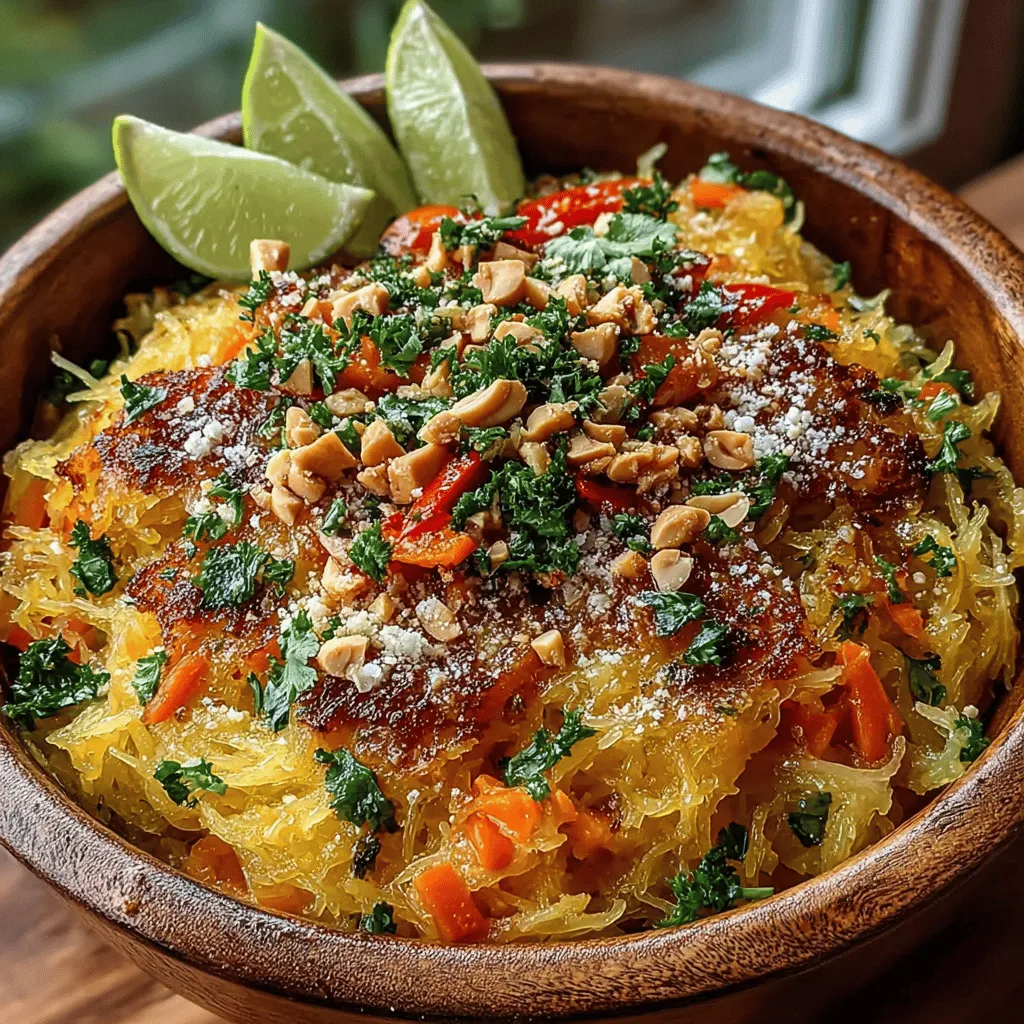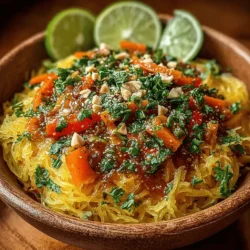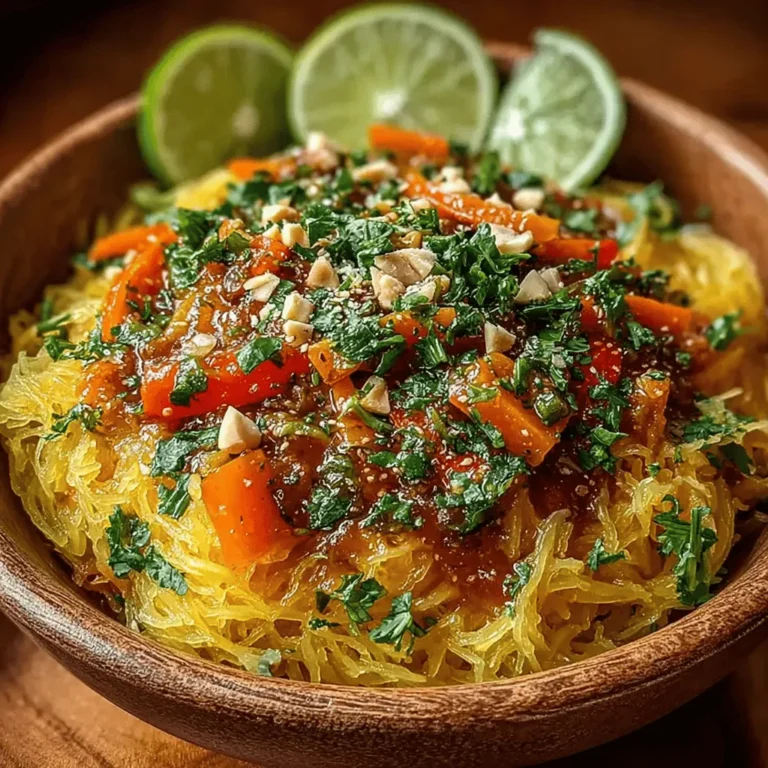Spaghetti Squash Pad Thai: A Delicious Low-Carb Twist on a Classic Thai Dish
In recent years, spaghetti squash has emerged as a popular low-carb alternative to traditional pasta, making it an ideal option for those looking to maintain a healthier lifestyle without sacrificing flavor. This innovative Spaghetti Squash Pad Thai recipe captures the essence of the beloved Thai dish while incorporating the nutritional benefits of spaghetti squash. By combining fresh vegetables and a creamy peanut sauce, this dish not only provides a delightful culinary experience but also caters to health-conscious eaters and those seeking gluten-free options.
Pad Thai, with its rich history and vibrant flavors, is a staple of Thai cuisine that has captured the hearts of food lovers around the world. Traditionally made with rice noodles, this dish is known for its balance of sweet, sour, and savory notes, highlighted by its signature sauce. However, by substituting spaghetti squash for the noodles, you can enjoy all the classic flavors of Pad Thai while significantly reducing the calorie count.
Understanding Spaghetti Squash
Defining Spaghetti Squash
Spaghetti squash is a unique variety of winter squash that, when cooked, separates into long, spaghetti-like strands. This fascinating vegetable is not only versatile but also easy to prepare, making it a favorite among those looking to create healthier meals. The mild flavor of spaghetti squash serves as a perfect canvas for absorbing the vibrant flavors of sauces and seasonings, allowing it to shine in dishes such as Pad Thai.
Exploring its Nutritional Benefits
One of the key reasons for the rising popularity of spaghetti squash is its impressive nutritional profile. Low in calories and rich in vitamins, this squash is an excellent choice for anyone looking to reduce their carbohydrate intake. A one-cup serving of cooked spaghetti squash contains approximately 42 calories, making it a guilt-free alternative to traditional pasta. Additionally, it is a good source of vitamins A, C, and B6, along with essential minerals like potassium and manganese.
Beyond its low-calorie count, spaghetti squash is also high in dietary fiber, which aids in digestion and promotes a feeling of fullness. This makes it an ideal ingredient for those looking to manage their weight while enjoying hearty, satisfying meals.
Comparing Spaghetti Squash to Traditional Pasta
When comparing spaghetti squash to traditional pasta, the differences in nutritional content become evident. While a cup of cooked pasta can contain over 200 calories and a significant amount of carbohydrates, spaghetti squash offers a much lighter option without compromising on texture or flavor. This makes it a fantastic choice for individuals following low-carb or ketogenic diets, as well as those simply looking to incorporate more vegetables into their meals.
The Essence of Pad Thai
Historical Background of Pad Thai
Pad Thai has a fascinating history that dates back to the 1930s in Thailand. It was introduced as part of a national campaign to promote the consumption of rice noodles, which were more affordable and accessible than other staples. The dish quickly gained popularity and became a symbol of Thai cuisine, celebrated for its balance of flavors and textures. Today, Pad Thai is often associated with street food culture in Thailand, where it is commonly served from food stalls and restaurants alike.
Key Ingredients in Traditional Pad Thai
The traditional version of Pad Thai is typically made with rice noodles, a combination of proteins such as shrimp, chicken, or tofu, and a flavorful sauce made from tamarind paste, fish sauce, and palm sugar. Topped with crushed peanuts, bean sprouts, and lime, this dish is a delightful explosion of flavors and textures. However, many modern adaptations have emerged, allowing for healthier twists on the classic recipe.
Healthier Alternatives in Modern Recipes
As health trends continue to evolve, many home cooks and chefs have sought ways to lighten traditional recipes without sacrificing taste. The use of spaghetti squash as a substitute for rice noodles is one such adaptation that has gained traction. By incorporating more vegetables, reducing sugar, and offering plant-based protein options, modern Pad Thai recipes cater to a wider range of dietary preferences while maintaining the original dish’s essence.
Ingredients Breakdown
Overview of Key Ingredients
Creating a delicious Spaghetti Squash Pad Thai requires a thoughtful selection of fresh ingredients. Each component plays a vital role in achieving the perfect balance of flavors and textures that make this dish so appealing. Let’s break down the key ingredients you’ll need:
– Spaghetti Squash: As the star of our dish, spaghetti squash is the low-calorie alternative to traditional noodles. When cooked properly, it transforms into tender strands that mimic the texture of pasta, allowing it to soak up the flavors of the sauce beautifully.
– Fresh Vegetables: A variety of colorful vegetables not only enhances the dish’s visual appeal but also boosts its nutritional value. Common choices include bell peppers, carrots, green onions, and bean sprouts, each contributing unique flavors and textures.
– The Importance of the Sauce: The sauce is the heart of any Pad Thai recipe. For this spaghetti squash version, a creamy peanut sauce made from peanut butter, soy sauce, lime juice, and a touch of sweetener creates a rich and indulgent flavor that ties all the ingredients together.
– Eggs vs. Tofu: Protein is an essential component of Pad Thai, and in this recipe, you can choose between eggs or tofu based on your dietary preferences. Eggs provide a rich source of protein and contribute to the dish’s creaminess, while tofu offers a plant-based option that is equally satisfying.
Step-by-Step Instructions for Spaghetti Squash Pad Thai
Preparing the Spaghetti Squash
To begin creating your Spaghetti Squash Pad Thai, the first step is to prepare the spaghetti squash. Start by preheating your oven to 400°F (200°C). While the oven is heating, carefully cut the spaghetti squash in half lengthwise and scoop out the seeds. Drizzle a little olive oil over the cut sides and sprinkle with salt and pepper for added flavor.
Next, place the squash cut-side down on a baking sheet lined with parchment paper. Roasting the squash in the oven for about 30 to 40 minutes will allow it to soften and create the perfect noodle-like strands. You’ll know it’s ready when you can easily pierce the skin with a fork. Once roasted, let it cool for a few minutes before using a fork to scrape out the flesh into spaghetti-like strands.
Making the Flavorful Sauce
While the spaghetti squash is roasting, it’s time to prepare the flavorful peanut sauce that will elevate your Pad Thai. In a mixing bowl, combine creamy peanut butter, soy sauce, lime juice, and a touch of honey or maple syrup for sweetness. Whisk these ingredients together until smooth, adjusting the consistency with a splash of water if necessary. The goal is to create a sauce that is rich and creamy, yet pourable enough to coat the spaghetti squash and vegetables evenly.
Sautéing the Vegetables
Once your sauce is ready, it’s time to sauté the vegetables. In a large skillet or wok, heat a tablespoon of oil over medium heat. Add your choice of chopped vegetables, such as bell peppers, carrots, and green onions, and sauté for a few minutes until they are tender yet still crisp. If you’re using tofu, you can add it at this stage as well, cooking until it is golden brown.
As you sauté the vegetables, add the spaghetti squash strands and the prepared peanut sauce to the pan. Toss everything together until the squash and vegetables are well coated in the sauce, allowing the flavors to meld together beautifully.
This initial preparation sets the stage for a delicious and nutritious Spaghetti Squash Pad Thai, combining the comforting elements of a classic dish with modern health-conscious choices. In the following sections, we will delve deeper into the nutritional benefits and the cultural significance of Pad Thai, as well as explore additional tips to enhance your cooking experience.



